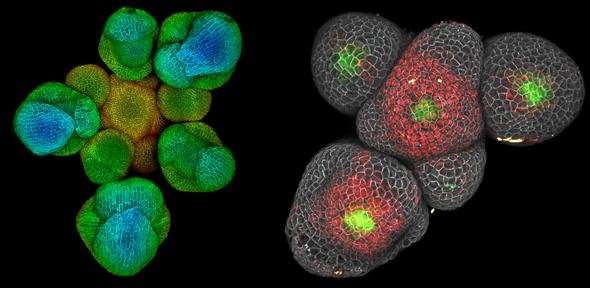Plants increase flower production within a day of soil nutrient application

The molecular mechanisms enabling plants to quickly adapt their rate of flower production in response to changing nutrient levels in soil have been revealed by researchers at the Sainsbury Laboratory.
A team of plant scientists examined the processes through which plants are able to pass on information about the external environment from the roots to the new shoots. The results showed that increased soil nutrients leads to a response in stem cells in the shoots in less than 24 hours.
Experiments showed that this rapid response occurred both in vitro at the microscopic level and ex vitro with entire plants beginning to increase the rate of stem cell growth and flower development in response to the application of nitrogen in the form of nitrate.
The scientists say that the study, published in Proceedings of the National Academy of Sciences, could contribute to improving crop yields by refining timing of fertiliser application and selective plant breeding.
First author of the paper, Dr. Benoit Landrein said that it was already well established that the availability of nitrate can affect various aspects of plant development. While it was known that plant hormones called cytokinins were involved in this root-to-shoot communication, the exact role of cytokinins in mediating the response of the meristem (the structure that produces all of the aerial organs of plant) to mineral nutrients had not been described before.
"Through this study, we provide an integrative model of the response of the meristem to a key environmental signal by showing that the cytokinins produced in the root in response to nutrients can modify the pool of stem cells in the meristem, which leads to a rapid change in the rate of flower production," Dr. Landrein said.

"Within one day of the root cells detecting additional nitrate, the cytokinin hormone precursors had travelled through the plant and converted to active hormones at the shoot meristem, which started influencing the shoot's growth. The speed of this process was very surprising – the roots had not only responded to the change in environment themselves, they had rapidly communicated this information from the roots to the stem cells at the very top of the plant. We observed shoot meristem cells were starting to respond within 24 hours of the application of nitrate."
Dr. Landrein is a member of the research groups of Professor Henrik Jönsson, Dr. James Locke and Professor Elliot Meyerowitz, which are working to increase our understanding of how cellular level processes in plants are controlled by gene regulatory networks, hormone transport and signalling, cell growth and division. Professor Jönsson said that while this latest research was undertaken in the plant Arabidopsis, the findings can be applied in future to crops.
"This research provides us with improved insight into how mineral nutrients influence plant architecture and could be used to better understand plant response to environmental inputs and to develop cultivars with increased yield. Crops where the same cytokinin action between roots and shoots occurs could significantly benefit from this. For example, genes involved in the regulation of cytokinins have been mapped in rice and maize and this knowledge could be utilised to select for plants with higher seed yields."
Plant stem cells
Stem cells in plants have the same function as stem cells in animals. They are undifferentiated cells that are capable of developing into specialised organ cells, such as leaves or flowers. Plant stem cells are located in the meristems of plants (growing tips of roots and shoots) and supply precursor cells from which the different parts of a plant grow from.
What are cytokinins?
Cytokinins are a class of plant hormones that control many different aspects of plant development and are involved in the response of the plants to environmental signals. The hormone notably acts as a messenger between the plant's roots and its shoots, communicating the availability of soil nutrients detected by the roots to the rest of the plant.
Arabidopsis
Arabidopsis is a member of the brassica family, which includes common commercially grown crops such as oilseed rape, cabbages, kale and Brussels sprouts. While recognised by most people as a weed that is commonly seen growing on roadsides, Arabidopsis was one of the first plants to have its entire genome mapped and is used as a model for studying plant biology.
More information: Benoit Landrein et al. Nitrate modulates stem cell dynamics inArabidopsisshoot meristems through cytokinins, Proceedings of the National Academy of Sciences (2018). DOI: 10.1073/pnas.1718670115
Journal information: Proceedings of the National Academy of Sciences
Provided by University of Cambridge





















